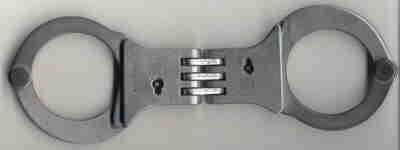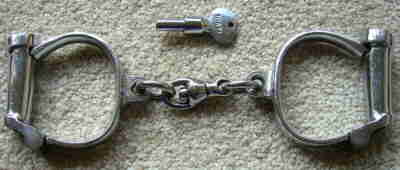 SKC Films Library SKC Films Library |
| SKC Films Library >> Sociology >> Social Pathology >> Police |
| Handcuffs The word "handcuffs" was once spelled "handcops," and that spelling came from the Old English word "cops," meaning "chain or shackle." This is appropriate since the earliest restraints used on criminals were chains and shackles.
Today's handcuffs typically consist of two rings with ratchet devices that lock each ring on its respective wrist; the type most commonly used in both the United States and Europe has a short chain between the two rings that allows the handcuffed person to have some limited movement, but police in some jurisdictions use a type of handcuff with a hinge between the two rings instead, allowing them to be folded in half for easy storage without giving the handcuffed person a chance to try and break the connecting links. Standard cuffs can accomodate wrists from 6.5 to 8 inches in circumference without pinching the skin or being so loose as to allow the criminal to simply slip his/her hands out of the restraints; there are also models made specifically for juvenile offenders and for suspects with larger than average wrists.
History The first handcuffs similar to those of today were known as Darby Hancuffs. They consisted of two horseshoe-shaped metal rings connected by a short chain. The barrel-shaped locking mechanism on each ring had to be screwed open and shut, giving the person being apprehended ample time to struggle with the officer and potentially get away. The cuffs also only came in one size, meaning they were totally ineffective on anyone with smaller than average wrists and may not have closed at all on someone with larger than average wrists. Darby Hancuffs W.V. Adams patented handcuffs with adjustable ratchets in 1862; his cuffs had a square bow with notches on the outside that engaged a lock mechanism shaped like a teardrop. A few years later, Orson C. Phelps patented a version with the ratchet notches on the inside of the bow. In 1871, John Tower improved on both designs by using round bows; his patent was granted in 1874. Tower patented the double-lock handcuff in 1879, and the swing-through ratchet that is standard on all modern handcuffs was patented by the Peerless company in 1912. |
| SKC Films Library >> Sociology >> Social Pathology
>> Police This page was last updated on July 05, 2017. |


